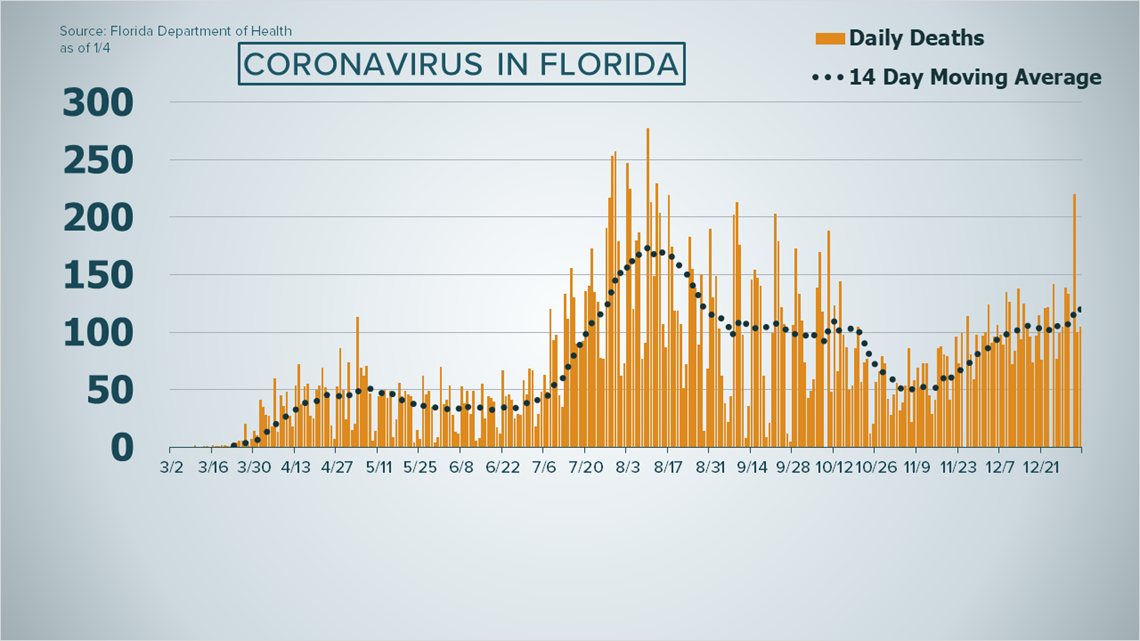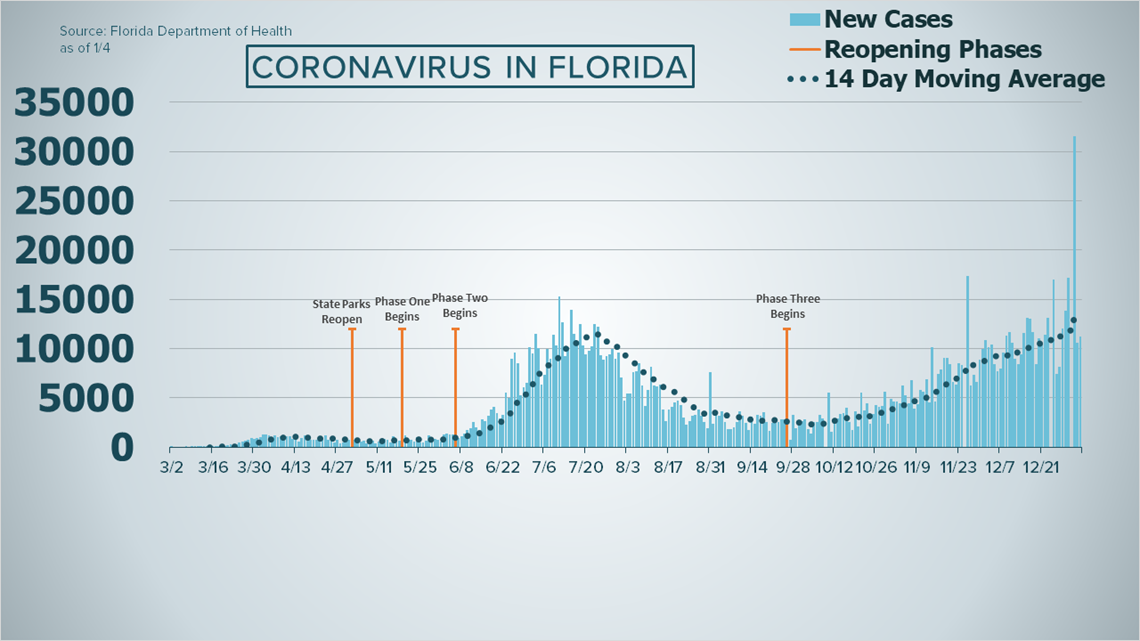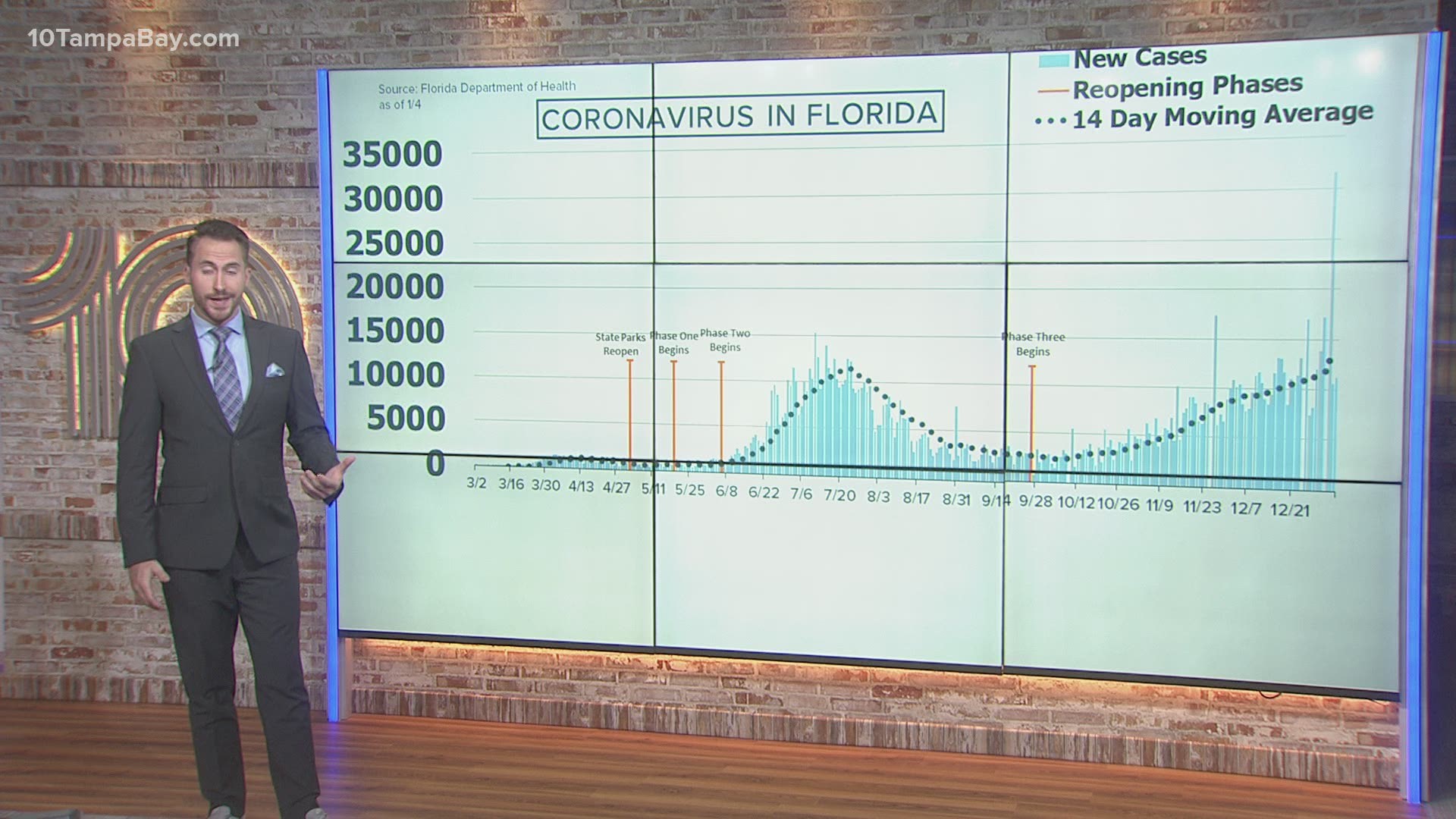TALLAHASSEE, Fla. — Florida added 11,256 new cases of COVID-19 for Jan. 3, according to the Department of Health's latest report.
A total of 1,376,692 people in Florida have tested positive for coronavirus since the pandemic began.
Last month, Florida became the third state to report more than 1 million cases, after California and Texas. Florida alone added 315,149 new cases of COVID-19 in December -- roughly 6,000 fewer cases than the peak in July.
So far this January, the state has reported 53,377 cases, with the bulk of that number representing a two-day report because of the New Year holiday.
On Monday, the state also reported another 103 Floridians and two non-residents had died after testing positive for COVID-19. That brings the total to 22,090 residents and 325 non-residents who have died since the pandemic began -- a total of 22,415 deaths in the state related to the virus.


Those numbers do not necessarily mean those people died Sunday, but rather the state learned of their deaths and added the number to the report that day. The state's line-by-line report, which you can read here, lists coronavirus deaths by the date the people tested positive for the virus, not the date they passed.
As for testing, the health department reported 12.52 percent of 104,014 test results returned from labs were positive for coronavirus through Jan. 3.
The median age of Floridians testing positive is 41.
As for hospitalizations, 7,225 people in Florida were hospitalized with coronavirus as their primary diagnosis as of Monday afternoon. Of those, 1,754 patients were in the Tampa Bay area.
Statewide, a total of 63,505 people in Florida were hospitalized with the virus at some point during the pandemic.
Here's a breakdown of new coronavirus cases reported to the state in December and the beginning of the new year:
- December 1: 9,994
- December 2: 10,870
- December 3: 10,177
- December 4: 10,431
- December 5: 8,436
- December 6: 7,711
- December 7: 7,985
- December 8: 9,592
- December 9: 11,335
- December 10: 11,699
- December 11: 10,577
- December 12: 8,958
- December 13: 8,452
- December 14: 9,411
- December 15: 11,541
- December 16: 13,148
- December 17: 13,000
- December 18: 11,682
- December 19: 8,401
- December 20: 11,015
- December 21: 10,434
- December 22: 11,384
- December 23: 13,147
- December 24: Report not released due to Christmas
- December 25: 17,042
- December 26: 7,391
- December 27: 8,198
- December 28: 12,075
- December 29: 13,871
- December 30: 17,192
- December 31: Report not released due to the new year
- January 1: 31,518
- January 2: 10,603
- January 3: 11,256


Understanding the numbers
Since mid-July, daily reported COVID-19 cases in Florida remained under 10,000. And, between Sept. 1 and Oct. 16, daily reported cases stayed below 4,000.
That changed on Nov. 15, when the state reported 10,105 new cases for the day prior.
The highest single-day case number Florida has reported so far is 17,192 for Dec. 31. The report released on Nov. 27 of 17,345 newly-reported cases is higher, but that reported combined updates for Nov. 25 and Nov. 26.
The lowest single-day case number the state has reported since early June is 738 confirmed on Sept. 28.
On Oct. 30, Florida became the third state to cross the 800,000 reported COVID-19 cases mark. Then on Dec. 1, Florida became the third state to surpass 1 million confirmed cases. As of Jan. 4, California and Texas have 2.4 and 1.8 million cases, respectively, according to Johns Hopkins University of Medicine.
According to Johns Hopkins University of Medicine, the United States has more than 20.5 million coronavirus cases as of Jan. 3, the highest recorded number in the world.
The state's report released on Aug. 11 of 277 newly confirmed deaths was the highest seen from the state in a single day's report.
The state added a section to its daily report (on page 5) that shows deaths by date of death. This data has been reported daily on Florida's COVID-19 dashboard. The graph for deaths by date of death is subject to change, though, because the information reported to the state can be delayed up to two weeks. So, for consistency, our charts have stuck to new deaths added by the date they were added. For transparency, you can always reference the state's data here.
The positivity rate is crucial for reopening. The World Health Organization has repeatedly said it must remain at 5 percent or lower for a 14-day span for the agency to recommend reopening.
However, it can be somewhat misleading: The number of people tested statewide varies each day. Health officials say they would like to see a high -- but steady -- number of people tested every day and a suppressed percent positivity figure.
Florida has been in "Phase 3" of reopening since Sept. 25, when Gov. Ron DeSantis signed an order guaranteeing restaurants the right to operate and lifting state-level capacity restrictions on them.


Hospitalizations and ICU bed availability
New cases have risen significantly in recent months, but what about hospitalizations?
Tracking hospitalizations got easier on July 10 when the Agency for Health Care Administration began publishing a spreadsheet with the number of people currently checked-in for coronavirus-related complications in Florida. The data only includes people whose "primary diagnosis" was COVID-19.
As of Jan. 4, 7,225 people were hospitalized with COVID-19 as their primary diagnosis statewide, and 1,754 of them were in the Tampa Bay area. Those numbers are frequently updated, and you can click here for the most recent data, which is also broken down by county.
Since the pandemic began, the state confirms a total of 63,332 residents were hospitalized at some point during their illness.
The Agency for Healthcare Administration (AHCA) also updates total hospital bed and ICU availability by county.
Click here for a breakdown of adult and pediatric ICU bed availability by county. You can also check ICU availability by the hospital.
Hospitalizations around Tampa Bay and total staffed hospital bed capacity status:
**Data as of 2 p.m. Jan. 4, 2021
Citrus:
- 59 COVID-19 hospitalizations
- 64 of 299 total staffed hospital beds are available
DeSoto:
- 9 COVID-19 hospitalizations
- 29 of 58 total staffed hospital beds are available
Hardee:
- 0 COVID-19 hospitalizations
- 0 of 25 total staffed hospital beds are available
Hernando:
- 96 COVID-19 hospitalizations
- 159 of 726 total staffed hospital beds are available
Highlands:
- 58 COVID-19 hospitalizations
- 62 of 269 total staffed hospital beds are available
Hillsborough:
- 461 COVID-19 hospitalizations
- 870 of 4,230 total staffed hospital beds are available
Manatee:
- 87 COVID-19 hospitalizations
- 99 of 804 total staffed hospital beds are available
Pasco:
- 193 COVID-19 hospitalizations
- 255 of 1,420 total staffed hospital beds are available
Pinellas:
- 383 COVID-19 hospitalizations
- 701 of 3,141 total staffed hospital beds are available
Polk:
- 290 COVID-19 hospitalizations
- 301 of 1,720 total staffed hospital beds are available
Sarasota:
- 118 COVID-19 hospitalizations
- 201 of 1,269 total staffed hospital beds are available
►Breaking news and weather alerts: Get the free 10 Tampa Bay app
►Stay In the Know! Sign up now for the Brightside Blend Newsletter

